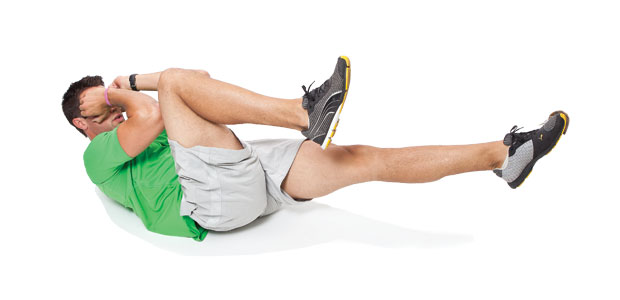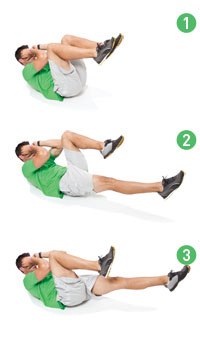
Core strength is the most essential component of any complete physical training program. Without it, athletes lack functional strength and leave themselves open to fatigue and injury. Whether professional athlete or weekend warrior, gym-goer or home exercise buff, add core-specific exercises to your program to maximize strength and stability.
The core is defined as the muscles used to stabilize the pelvis and spine. It is composed of five main muscle groups: the pelvic floor, transversus abdominis (TVA), internal and external obliques, erector spinae, and rectus abdominis. Each muscle group is as important as the next for strength and stabilization, and each requires proper care and attention to get the most out of your athletic performance.
Pelvic floor
The pelvic floor is the easiest muscle to activate, although it may be difficult to engage at first. To practise engagement, simply employ the same muscles used to stop peeing. It’s so easy, you can do it at your desk and no one will ever know.
Transversus abdominis (TVA)
Imagine the transversus abdominis (TVA) as the girdle of our body. It wraps around the midsection from spine to belly button and is the source from which any athlete draws functional strength, power, and stability.
To activate the TVA, imagine you are being given a giant hug around your waist, nice and tight. If you are still having trouble, cough. That tightness around the abdomen is your TVA being activated. Contracting the TVA increases intra-abdominal pressure and has been shown to be critical in stabilization of the lumbar spine, which is vital to everyone, especially athletes in contact sports such as rugby, football, or hockey.
Internal and external oblique muscles
Our third muscle group, the internal and external obliques, is the first of our visible core muscles and is the driving force in trunk rotation. These are the V-shaped muscles that constitute the visible lower abdomen and follow the shape of our hip bones.
Strengthening these muscles will help you change directions faster while maintaining balance. Your lower back will also be protected from stress and injury caused by sudden trunk rotation, crucial for rotational sports such as tennis or downhill skiing.
Erector spinae
The erector spinae are often ignored, but they won’t be denied. One of the most universal complaints, especially among those with sedentary jobs or lifestyles, is back pain. This muscle group runs along the spinal column and helps keep you upright and in proper posture. For swimmers and cyclists, the erectors are key in extension of the spine. Strong lower back muscles are crucial to proper form, which equates to greater speed.
Rectus abdominis
The rectus abdominis is the star of the show. It is the sleek and sexy muscle that graces the packaging of every well-meaning fitness product and is the head turner at the beach. It is also the muscle that volleyball players rely on for ball-splitting spikes and that runners depend on for endurance and significant improvement of running times.
Now it’s time to put these muscles to work in some functional strengthening exercises. Once you master these, your performance on and off the athletic stage will show amazing improvement.
Plank Kickouts

- Assume a plank position with elbows directly below the shoulders, legs extended straight behind you, and a slight bend at the hips so they’re level with the shoulders.
- Engage your pelvic floor and TVA to ensure your pelvis is stabilized.
- With the upper body stable, drive one knee toward your chest as far as it can go and twist your hips, passing bent leg underneath, so your hips open to the wall on the same side as your anchor leg.
- Extend this leg so that it’s straight, and touch your foot to the floor as far away from you as possible without letting your arms shift or come off the ground.
- After 10 to 15 reps repeat the movement in a controlled manner with the other leg.
Morning glory

- To begin, kneel on the ground with knees under hips. You can widen your stance to make it easier.
- Sit down on your feet tucked underneath you, and bend forward as low as possible with arms open to sides and hands touching your ears.
- Ensure that your pelvic floor and TVA are engaged.
- While maintaining a neutral spine and neck, extend your upper body and lift chest to return to the upright position.
- Make sure the shoulder blades are consistently squeezed together and downward to maintain a neutral spine.
- Increase difficulty by extending one leg behind with the same arm in front. Raise arm and chest as before.
- Repeat this motion 10 to 15 times, then switch sides.
 Crunch kickouts
Crunch kickouts
- Lie on your back with knees bent and feet flat on the ground.
- Engage your pelvic floor and TVA.
- With hands touching your ears and elbows pointing forward, bring your shoulders up off the floor into a crunch position.
- While in the crunch position, bring your feet off the floor so that your knees touch your elbows.
- Slowly extend one leg until straight out and off the ground while the other leg is still bent, with your knee touching your elbow.
- Alternate legs in a controlled manner.
- Complete 10 to 15 extensions of each leg. If you’re still feeling strong, go until you can no longer maintain at least one elbow touching your knee!
For more information on core-revealing nutrition, take a moment to visit your local natural health store. If you are looking for a way to enhance your game or get more from your body, don’t ignore your core. If you take care of it, it will take care of you.



































